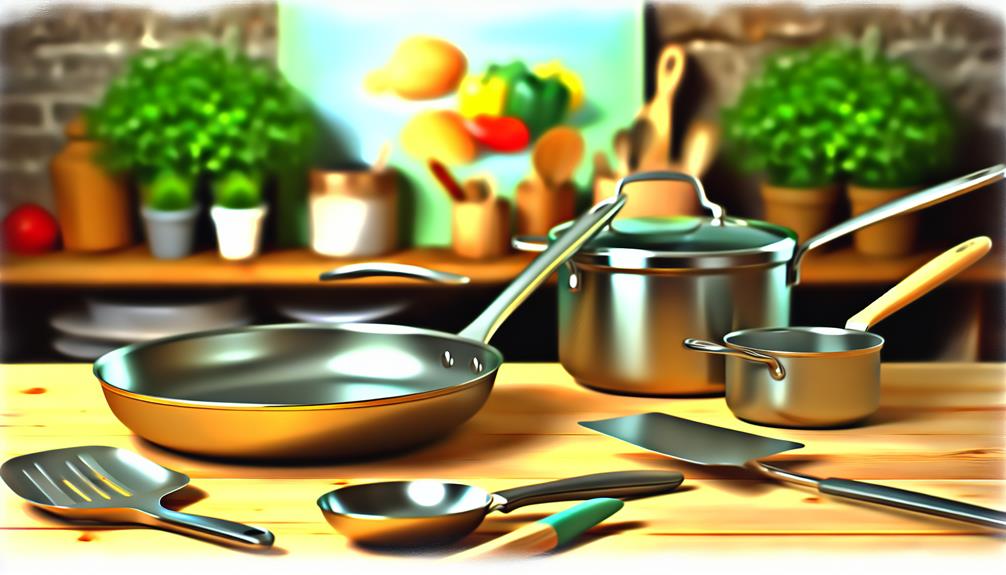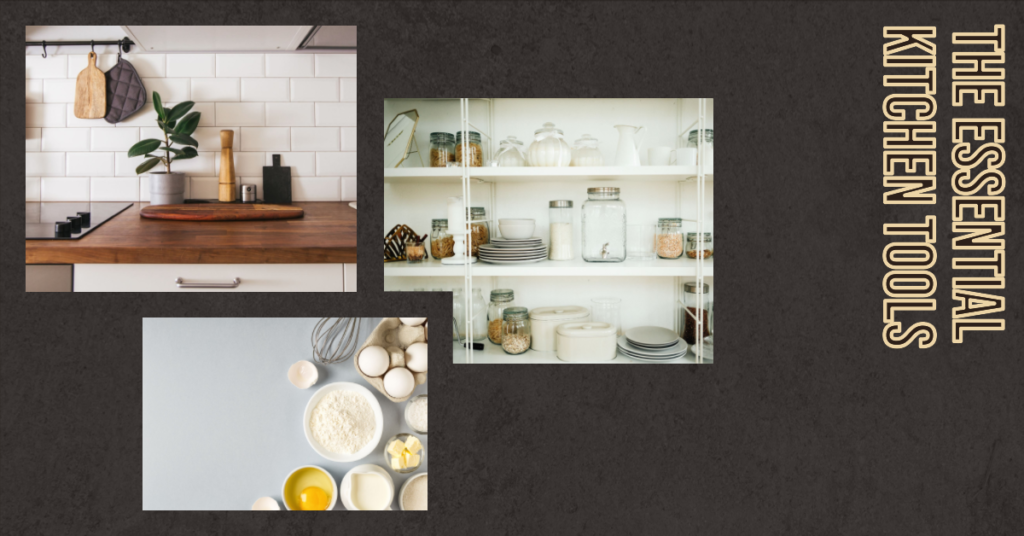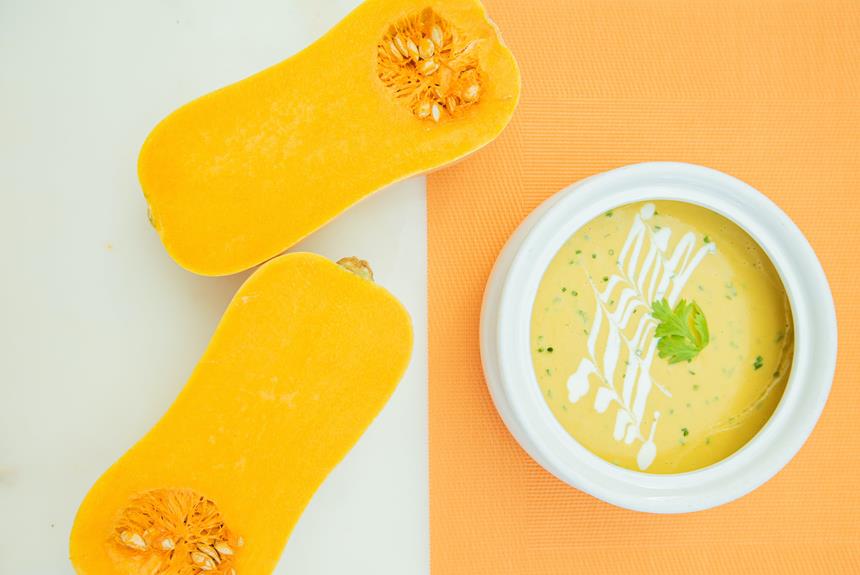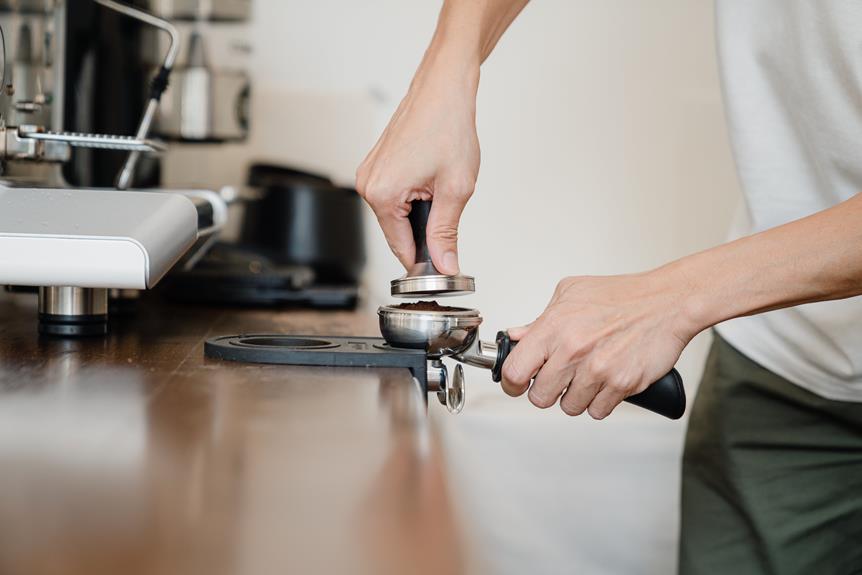As a beginner home chef, you’ll want to stock your kitchen with must-have cookware to tackle a variety of dishes. Start with a versatile frying pan for omelets to seared steaks, and a sturdy skillet for stovetop success. Saucepans are a must for flexibility and space-saving storage, while Dutch ovens excel at slow-cooking tender meats and hearty stews. Don’t forget a stockpot for massive batches and non-stick cookware for easy food release. Cooking utensils and essential kitchen tools, like measuring cups and a can opener, will complete your setup. As you get cooking, you’ll discover even more ways to elevate your culinary game. Compact cookware sets are a great investment for beginner home chefs, as they often include a variety of essential pots, pans, and utensils in one convenient package. Look for sets that include a range of sizes and styles to cover all your cooking needs. With the right cookware at your fingertips, you’ll be well-equipped to experiment with new recipes and techniques in the kitchen.
Frying Pans for Every Meal
Start building your cookware collection with a versatile frying pan that can tackle everything from omelets to seared steaks.
You’ll quickly realize it’s a workhorse in your kitchen, perfect for whipping up breakfast, lunch, or dinner.
As you continue to cook with your new pan, remember that pan maintenance is key to extending its lifespan.
Regularly clean your pan with soap and water, and avoid using abrasive materials that can scratch the surface.
When it comes to meal planning, a frying pan offers endless possibilities.
You can sauté vegetables, cook proteins, and even make a hearty stir-fry.
Consider meal prepping on the weekends and using your pan to cook a batch of rice or roasted vegetables that can be used throughout the week.
With a little creativity, you’ll be able to create a week’s worth of meals using just your frying pan.
Saucepans for Cooking Variety
As you start building your cookware collection, you’ll find that saucepans are a vital addition for cooking a variety of dishes.
When choosing the right saucepan for you, you’ll want to think about a few key factors that’ll make all the difference in your cooking experience.
You’ll need to reflect on the size options that’ll work best for you, how the material will distribute heat, and the type of material that fits your cooking style.
Versatile Size Options
With a range of saucepan sizes at your disposal, you can tackle a variety of cooking tasks, from whipping up a single serving of oatmeal to simmering a large batch of homemade pasta sauce.
This versatility is essential for beginner home chefs, as it allows you to cook for one or a crowd with ease.
Having multiple saucepan sizes also serves as a space saver, as you can choose the right pan for the job, rather than relying on a single large one that takes up valuable storage space.
Moreover, having saucepans in various sizes provides meal flexibility.
You can cook a small side dish in a tiny saucepan, while simultaneously preparing a larger main course in a bigger one.
This flexibility also allows you to adjust your cooking based on the number of guests you’re hosting or the ingredients you have on hand.
With the right size saucepan, you can confidently tackle any recipe, from a simple weeknight dinner to a complex holiday feast.
Heat Distribution Matters
Heat distribution is a game-changer when cooking a variety of dishes, from searing meat to simmering soups. A saucepan that excels in heat distribution can make all the difference in achieving perfect doneness and texture.
When shopping for cookware, look for saucepans with high thermal mass, which allows them to absorb and distribute heat evenly. This facilitates that your dishes cook consistently, without hotspots or undercooked areas.
Conductive cores, such as copper or aluminum, are also essential for excellent heat distribution. These materials are excellent heat conductors, allowing heat to spread quickly and evenly throughout the pan.
This means you can achieve a perfect sear on your steak or cook delicate sauces without scorching. Additionally, saucepans with conductive cores tend to heat up faster and maintain a consistent temperature, making cooking more efficient and enjoyable.
Material Choices Abound
Different cooking tasks demand unique material characteristics, and choosing the right saucepan material can profoundly impact the flavor, texture, and overall success of your dishes.
You’ll find that various materials cater to specific cooking techniques, making it essential to understand their strengths and weaknesses.
Copper, for instance, is an excellent heat conductor, making it ideal for delicate sauces and precision temperature control. Copper benefits include exceptional heat distribution, which allows for a more even cooking experience. However, it can be expensive and requires regular maintenance to prevent oxidation.
On the other hand, Stainless steel saucepans offer durability, non-reactive properties, and ease of cleaning. Stainless considerations include its ability to distribute heat evenly, although it may not be as efficient as copper. Additionally, it’s often more affordable and resistant to scratches and corrosion.
When selecting a saucepan, consider the type of cooking you’ll be doing most often. Will you be whipping up omelets or searing steaks? By understanding the characteristics of each material, you’ll be better equipped to choose the perfect saucepan for your cooking needs, ensuring that your dishes turn out flavorful, textured, and mouth-watering.
Dutch Ovens for Hearty Dishes
Dutch ovens, known for their thick walls and tight-fitting lids, excel at slow-cooking tender, fall-off-the-bone meats and hearty stews that’ll become staples in your culinary repertoire.
As you explore the world of Dutch oven cooking, you’ll appreciate the benefits of ceramic glazing, which enhances heat distribution and prevents food from sticking to the pot.
With a Dutch oven, you can master various cooking techniques, such as braising, roasting, and stewing. Try searing meat on the stovetop, then transferring the pot to the oven for a slow-cooked meal that’s full of flavor.
You’ll also appreciate the versatility of Dutch ovens, which can go from stovetop to oven to table, making them perfect for one-pot meals.
Whether you’re cooking up a hearty beef stew or a tender chicken cacciatore, a Dutch oven is an essential tool for any beginner home chef.
With practice and patience, you’ll discover the full potential of this versatile cookware and enjoy delicious, comforting meals for years to come.
Stockpots for Big Batches
When cooking for a crowd, a stockpot is your go-to vessel for preparing massive quantities of soups, stews, or pasta dishes that’ll satisfy everyone’s appetite.
You’ll be amazed at how efficiently you can cook large batches with this essential cookware. For instance, you can whip up a huge batch of chili or stew that’ll feed your family and friends for days.
Stockpots are perfect for batch cooking, allowing you to prepare meals in advance and refrigerate or freeze them for later use.
When choosing a stockpot, consider the material and size. Stainless steel or enameled cast iron stockpots are durable and easy to clean.
A larger pot (at least 12-quart capacity) will give you the flexibility to cook massive quantities.
To guarantee your stockpot lasts, remember to clean it thoroughly after each use and dry it to prevent rust.
With proper pot maintenance, your stockpot will become a trusted companion in the kitchen, helping you to cook up a storm for years to come.
Skillets for Stovetop Success
You’ll be reaching for your skillet more often than you think, as it’s the ultimate stovetop workhorse for searing, sautéing, and simmering a variety of dishes.
Whether you’re cooking breakfast, lunch, or dinner, a good skillet is an essential tool in your kitchen arsenal.
When choosing a skillet, consider the material – stainless steel, cast iron, or hard anodized aluminum are popular options. Each has its own benefits, so think about your cooking style and preferences.
To keep your skillet in top condition, proper maintenance is key.
Avoid using abrasive cleaners or scourers, as they can scratch the surface. Instead, wash your skillet by hand with mild soap and dry it thoroughly to prevent rust.
For tough stains, mix baking soda and water to create a gentle cleaning paste.
As for skillet decor, think beyond just functionality. A stylish skillet can add a pop of color and personality to your kitchen.
Look for skillets with vibrant handles or unique designs to add some visual appeal to your cooking space.
With the right care and a dash of style, your skillet will become your go-to cooking companion.
Non-Stick Cookware for Easy Food
When you’re cooking with non-stick cookware, you’ll love how effortlessly your dishes turn out.
You’ll find that food releases easily and slides out of the pan with minimal effort, making cooking and cleaning a breeze.
With non-stick cookware, you can say goodbye to stuck-on food and hello to a stress-free cooking experience.
Easy Food Release
Non-stick cookware makes food release a breeze, allowing you to effortlessly slide omelets, pancakes, and delicate fish fillets onto your plate.
This is made possible by the advanced release technology used in non-stick cookware. When you cook with non-stick, you can be sure that your food won’t stick to the cookware’s surface, making it easy to flip, stir, and serve.
The food surface is coated with a thin layer of non-stick material that prevents food from bonding with the cookware. This means you can cook delicate foods like eggs, crepes, and pancakes without worrying about them breaking apart when you try to flip or remove them.
With non-stick cookware, you’ll spend less time scrubbing away at stuck-on food and more time enjoying the fruits of your labor.
The easy food release feature also makes cooking healthier, as you can cook with less oil and butter. Additionally, non-stick cookware is easy to clean, and most are dishwasher safe, making meal prep and cleanup a snap.
Food Slides Out
Food effortlessly slides out of non-stick cookware, making cooking and serving a breeze.
You’ll be amazed at how easy it’s to cook and plate your dishes with this type of cookware. Gone are the days of scrubbing away at burnt pans or struggling to get food out of sticky surfaces.
With non-stick cookware, you can focus on perfecting your cooking techniques and experimenting with new kitchen hacks.
When you’re cooking with non-stick pans, you can try out new recipes and cooking methods without worrying about the food sticking.
Try cooking delicate fish or omelets with ease, or whip up a quick stir-fry with confidence. Non-stick cookware makes cooking and cleaning a cinch, giving you more time to focus on the fun parts of cooking.
Plus, it’s a great way to reduce oil and butter usage, making your dishes healthier and more flavorful.
With non-stick cookware, you’ll be cooking like a pro in no time, and your taste buds (and your kitchen) will thank you.
Cooking Utensils for Every Task
As you step into the world of cooking, having the right utensils can make all the difference in building your kitchen essentials and cooking confidence.
You’ll need a set of utensils that can tackle every task, from prep to plate. A good starter set should include a stainless steel or silicone spoon, a slotted spoon, a spatula, and a set of tongs. These will help you stir, scoop, and flip your way to culinary success.
Invest in a set of measuring cups and spoons to guarantee accurate measurements. A can opener, garlic press, and kitchen shears will also become your trusted sidekicks. Don’t forget a set of oven mitts to protect your hands from hot dishes. With these utensils, you’ll be well-equipped to tackle any recipe that comes your way. Remember, having the right tools can boost your cooking confidence and make the entire cooking process more enjoyable.
Essential Kitchen Tools for Beginners
As a beginner home chef, you’re probably wondering what essential kitchen tools you need to get started.
You’ll need a set of measuring cups and spoons, a can opener, and a kitchen timer. These tools will help you measure ingredients accurately, open canned goods with ease, and keep track of cooking time.
Next, consider investing in a garlic press, a silicone spatula, and a set of kitchen shears. These tools will help you chop garlic efficiently, scrape the sides of bowls with ease, and cut herbs with precision.
Having these essential kitchen tools won’t only make cooking easier but also boost your cooking confidence. With the right tools, you’ll be able to tackle recipes with ease, and that’s when the kitchen hacks come in handy.
For instance, using a silicone spatula to flip pancakes or using kitchen shears to cut herbs for a fresh salad. With practice and patience, you’ll become a pro in no time!
Conclusion
You’ve got the basics covered!
With these must-have cookware pieces, you’re ready to tackle any recipe that comes your way.
From frying pans to stockpots, and from non-stick cookware to cooking utensils, you’ve got the tools to cook up a storm.
Now, get cooking and experiment with new recipes – your kitchen is equipped and you’re ready to shine!





